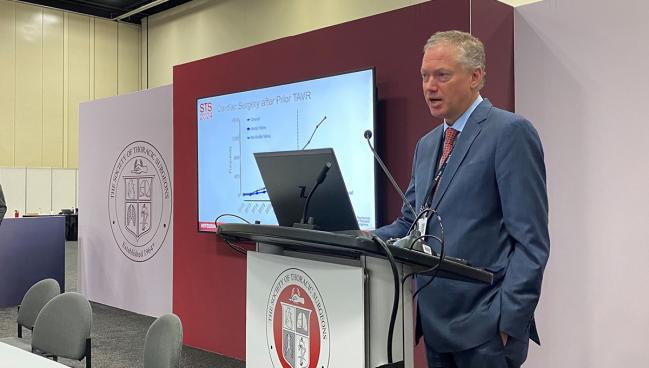SAVR After Failed TAVI on the Rise, With High Mortality
Notably, all cardiac surgeries after TAVI are increasing. Treating this high-risk group will be a new challenge for surgeons.

SAN ANTONIO, TX—More and more patients who undergo TAVI go on to have cardiac surgery, with high operative mortality, new data from the Society of Thoracic Surgeons (STS) Adult Cardiac Surgery Database show. When these surgeries are SAVR after a failed TAVI, this can be especially challenging, experts argued at the recent STS meeting.
Prior data have demonstrated the dangers associated with TAVI explant, and that these procedures are on the rise, especially as the intervention became available for lower-risk patients. But the upswing in cardiac surgeries more generally also presents a challenge.
“Surgery after TAVR is hard,” Michael E. Bowdish, MD, MS (Cedars-Sinai Medical Center, Los Angeles, CA), who presented the late-breaking data at the meeting told TCTMD. “It is interesting, even in patients who had a CABG or mitral valve [surgery] after TAVR have increased risk. So it's not entirely just taking the TAVR out and putting a new one in. There are things inherent about these patients we don't entirely understand that are making them behave like sicker patients than they . . . might have looked when they had their TAVR.”
Shinichi Fukuhara, MD (University of Michigan, Ann Arbor), the study’s discussant, was captivated by the failed TAVI procedures in particular, calling TAVI explants a “pandemic” in cardiac surgery. Fukuhara told TCTMD he performed the 101st TAVI explant at his institution the week before the meeting and a few months ago did an operation explanting a total of five prosthetic valves from a single patient—two TAVI valves, one surgical aortic valve, one transcatheter mitral valve, and one surgical mitral valve.
“If we look at just the short-term data for those that have TAVR, redo TAVR, valve-in-valve with TMVR, yeah, those look good because almost nobody dies,” he said. “But if we look even beyond 1 year, I don't think that's as favorable as what our communities are hoping.”
Trends in Post-TAVI Cardiac Surgery
For the study, Bowdish and colleagues looked at all patients in the STS registry who underwent cardiac surgery following a TAVI between January 2012 and March 2023, excluding those who, at the time of TAVI, had either emergent SAVR or the repair of aortic dissection or rupture. In total, they included 2,485 patients undergoing non-SAVR cardiac surgery—mostly CABG and mitral valve surgery—and another 2,972 who underwent SAVR with or without another cardiac surgery—most commonly concomitant aortic or root procedure followed by mitral valve or CABG surgeries.
Mean age was 73 years, and 38.6% were female. Baseline characteristics were similar between the two study arms, except for a greater prevalence of aortic stenosis in those who underwent SAVR compared with other types of cardiac surgery. Notably, the main reason for SAVR was structural valve deterioration (64%), followed by endocarditis (36%). Most operations (87.5%) were elective or urgent, and 14.1% had at least two previous sternotomies.
Post-TAVI cardiac surgeries on the whole increased around fourfold between 2017 and 2023, according to curves shown by Bowdish, with a clear inflection point when the US Food and Drug Administration approved TAVI for patients at low surgical risk in 2019. Both SAVR and mitral replacement are growing the most, Bowdish said.
Another curve showed how aortic valve surgeries increased by nearly fivefold between 2017 and 2023. Most of the rise was seen in SAVR-only cases, with a smaller increase seen in surgeries that involved SAVR plus the aorta or root.
Overall operative mortality was “very, very striking” at 15.8% for all cardiac surgeries, 17.9% for non-SAVR, and 14.1% for SAVR with or without other cardiac surgery, he reported. The overall risk of stroke was 4.5%, and this was similar regardless of type of cardiac surgery.
Compared with existing STS risk models for mortality, patients in all categories of cardiac surgery did worse than expected: observed-to-expected ratios ranged from 1.21 for mitral valve repair plus CABG to 2.11 for mitral valve replacement. “We can see that our models do not perform very well,” Bowdish said. “When you see a patient and you tell them you try to model or think about what's your real risk, if you use existing risk calculators, you’re nowhere in the same ballpark.”
If you use existing risk calculators, you’re nowhere in the same ballpark. Michael Bowdish
The results should be considered by all clinicians when thinking about TAVI in younger patients, he concluded. “It really is incumbent upon us as a society to talk about how to deal with these kinds of patients. There are going to be more and more of these patients in our practices, and as a database. . . . How do we deal with these from a reporting and a modeling standpoint going forward?”
‘Canary in the Coal Mine’ for Failed TAVI?
“Obviously, this data [on SAVR] is the canary in the coal mine to a problem that is much larger,” said Vinay Badhwar, MD (West Virginia University, Morgantown), who served as a co-author on the study, during a deep-dive session looking at the practice patterns. “It's the fastest growing adult cardiac operation in the United States by volume over time.”
He further said these data were the “actual impetus” behind his team’s decision to publish the low-risk TAVI data last year. “People think it’s because of the trials [that were] coming out. It wasn’t. It was because of this,” he specified.
Badhwar suggested that current risk-prediction tools need to be adapted to account for TAVI explants, or potentially a whole new model needs to be created. “The issue is these cases are being done not only in quaternary institutions—they're being done in our community,” he said. “Surgeons in this hallway have probably explanted a TAVR valve. And so it becomes a bigger issue.”
Reducing the mortality around secondary surgeries gets back to the initial decision to choose TAVI over SAVR for many of these patients, several panelists agreed. “One of the key reasons why this is really important to me is some of those discussions you have with your patients, when they use the logic of: ‘Well, you can get a surgical AVR down the road,’” Bowdish said. “Based on current data, that ‘down the road’ risk is very, very high.”
“It has to do with decision-making a priori for the life span of the patient,” Badhwar said, noting that TAVI is the best choice for some people. “We keep talking about the valve for the life of the patient and that kind of rhetoric. It's the choice for the life of the patient. That's the real choice.”
Tsuyoshi Kaneko, MD (Washington University School of Medicine in St. Louis, MO), another study co-author, brought up multiple new technologies that will help patients and physicians make the best-informed initial decisions. These include the Precision TAVI tool (Dasi Simulations) for simulating multiple aortic valve procedures as well as the ShortCut leaflet modification device (Pi-Cardia).
If we stretch to the point where we're planning a lifetime management, . . . I don't know if that's fair to our patients. Kevin Accola
While lifetime management is a priority Kevin Accola, MD (AdventHealth, Orlando, FL), stressed that “you've got to do the best operation for that particular person at that time within reason, with an asterisk of course if they have other comorbidities.
“We sometimes lose that and look at the technology—‘if we do this, then we can do that’—and the ripple effect of that initial splash. And so I think we have to keep that in mind,” he said. “If we stretch to the point where we're planning a lifetime management, . . . I don't know if that's fair to our patients.”
Bowdish agreed. “It's very important for you work with your patients, work with your cardiology colleagues, and in the absence of real data . . . in younger patients, we have to try to collectively make the best decision,” he said. “I’m hopeful that maybe sometime down the road, we’ll have some real data that is either trial data or joint registry data to try and inform our decision-making a little bit better in these populations.”
How to Reduce Mortality
As for how to start lowering the mortality for patients undergoing cardiac surgery after TAVI, Badhwar said awareness is key. “Surgeons who are going to be facing this may not be doing a lot of aortic valve surgery, a lot of TAVR operations or procedures,” he said. “Be aware of the anatomy, the unique aspects, the skirts, how to use the nitinol to your advantage, crimping, and endarterectomizing the inside of the aortic root. Basically, it’s a new pathoanatomy, so get to understand what that pathoanatomy is.”
Education is critical, according to Ourania Preventza, MD (University of Virginia, Charlottesville). “We have to keep really teaching the residents how to operate. We have to be there with them,” she said. “I think it's extremely important, especially as we are getting into coronary artery bypass after prior aortic valve replacement, as you get through TAVRs, how to explant TAVRs. We, as educators, . . . have to be in the forefront.”
If we are seeing younger people [with] ‘no redo TAVR anatomy,’ don't do TAVR. Shinichi Fukuhara
Fukuhara stressed that these operations are almost always urgent, so surgeons should be prepared. “Whether they are baseline low risk, intermediate risk, or high risk, at the time of surgery they are high risk,” he said. As such, the “multidisciplinary TAVR team concept remains important—we have to do a better job selecting the right patient for TAVR. . . . If we are seeing younger people [with] ‘no redo TAVR anatomy,’ don't do TAVR.”
The message should be relayed to patients as well, Fukuhara said, especially ones that might only be thinking of short-term goals instead of long-term survival. For many patients facing open-heart surgery, he explained, the initial reaction is, “No way. I would rather die,” but then 10 years later they might again be on the decline and want their doctor to do anything to help. “That's the majority of TAVR explant patients. That's sad. We could have easily avoided this situation if we had performed high-quality SAVR when the patient was 10 years younger,” Fukuhara said.
Yael L. Maxwell is Senior Medical Journalist for TCTMD and Section Editor of TCTMD's Fellows Forum. She served as the inaugural…
Read Full BioSources
Bowdish ME. Cardiac surgery after transcatheter aortic valve replacement – trends and outcomes. Presented at: STS 2024. January 28, 2024. San Antonio, TX.
Disclosures
- Bowdish reports no relevant conflicts of interest.
- Fukuhara reports serving on the advisory board for Artivion and as a consultant to Artivion, Edwards LifeSciences, Medtronic, and Terumo Aortic.





Comments